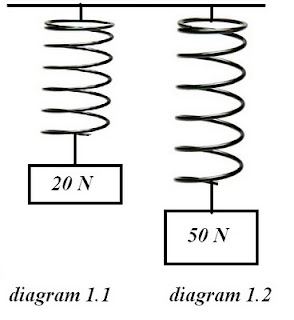A student investigate how the extension of a spring changes with the load acting on a spring.
Diagram 1.1 and 1.2 show what happens when two different loads are hang on two identical springs.Based on the information and the observation above:
Berdasarkan maklumat dan pemerhatian di atas:
a) State one suitable inference that can be made
Nyatakan satu inferens yang sesuai [1 mark]
* pesanan :
baca soalan dengan teliti dan carikan pembolehubah yang tersurat dalam maklumat yang diberi.
Contohnya pemboleh ubah boleh laras ( manipulated variable ) ialah beban load // force // mass) yang digunakan , dan pemboleh ubah bersandar ( responding variable) ialah pemanjangan spring. ( extention of spring ).
Sambungkan pemboleh ubah yang dikesan dengan kata kunci seperti
i) MV influences RV
ii) RV is influenced by MV
iii) RV depends on MV.
b) State one appropriate hypothesis for an investigation
Nyatakan satu hipotesis yang sesuai dikaji [1 mark]
* pesanan :
Tuliskan hubungan MV dengan RV .
c) With the use of apparatus such as a spring, slotted weights and other apparatus, describe an experimental framework to test your hypothesis stated in 2(b)
In your description, state clearly the following:
Menggunakan alat radas seperti spring, jisim berslot dan lain-lain radas yang sesuai, terangkan suatu rangka kerja eksperimen untuk menguji hipotesis anda di 3(b).
Dalam penerangan anda, jelaskan perkara-perkara berikut
(i) The aim of the experiment
Tujuan eksperimen
* pesanan :
Gunakan kata kunci
i) to study...
ii) to investigate...
(ii) The variables in the experiment
Pembolehubah didalam eksperimen
* pesanan :
senaraikan ketiga-tiga pemboleh ubah.
(iii) The list of apparatus and materials
Senarai radas dan bahan
* pesanan :
Alatan yang dicadangkan perlu disaling semula, dan pastikan alatan yang disenaraikan boleh digunakan untuk menguju MV dan RV yang anda cadangkan.
Contoh:
Pembaris (Meter rule ) --> mengukur panjang spring.
(iv) The arrangement of the apparatus
Susunan radas
* pesanan :
Lukiskan dan labelkan susunan radas yang berfungsi.
(v) The procedure of the experiment which include the method of controlling the manipulated variable and the method of measuring the responding variable.
Prosedur eksperimen termasuk kaedah mengawal pembolehubah dimanipulasi dan kaedah mengukur pembolehubah bergerakbalas
* pesanan :
Senaraikan arahan menguju MV dan RV, dicadangkan arahan mengulangi ujikaji sebanyak 4 kali .
(vi) The way you would tabulate the data
Cara untuk menjadualkan data
* pesanan :
Lukiskan jadual berlabel dan tandakan unit kuantiti fizikal.
(vii) The way you would analyse the data
Cara untuk menganalisis data [10 marks]
Suggested answer:
a) Inference :
The pulling force influences the extension of the spring//
The length of spring is influenced by the pulling force//
Length of spring depends on the force acting on it.
b) Hypothesis:
The bigger the force , the longer the spring.//
When the force(mass) increases, the length of the spring increase
C)
i) Aim:
To investigate the relationship between force //mass and the extension of the spring
ii)
Manipulated variable : Force, F// mass
Responding variable: Extension of spring, x
Fixed variable: Diameter// stiffness of spring/ the initial length, lo/ spring constant of spring,k
iii) List of apparatus/ materials :
Spring, pin, slotted weight, retort stand with clamp, meter rule and plasticine.
iv) Arrangement of the apparatus( with labels )
v)
~ Method of controlling the manipulated variable :
1. Determine the initial length, lo, without any slotted weight hung to the spring.
2. Hang a slotted weight of mass 50 g, (force/weight of 0.5 N) and measure the length of the spring .
~Method of measuring the responding variable :
3. Calculate the extension of the spring, x using the formula ( length l) – (initial length, lo)
~Repeating :
4. Repeat the experiment using mass of 100g, 150g, 200g and 250g (or force, F= 1.0 N, 1,5 N, 2.0 N and 2,5 N)
vi)


